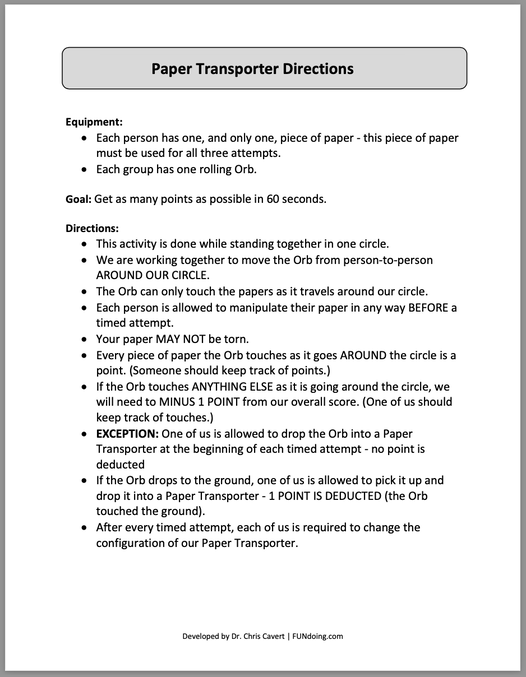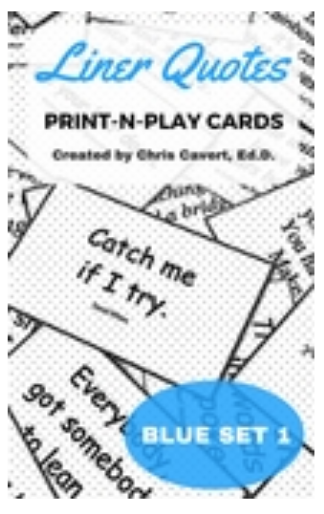Recently I developed this idea to target the concepts of creativity and change. (If you would like more of the backstory, and my developmental thinking about this activity, I've included it at the bottom of the post. Let's just get right to it....)
Objective: Explore the concepts of creative problem solving and innovation.
Preparation: I like to have about seven or eight people in a group. This allows for more active participation. So, if you have a larger group divide them into smaller groups. (I would lead this activity with up to 12 small groups of seven or eight participants.)
|
You'll need one 8.5 x 11-inch piece of paper for each person (and have some extras just in case) and one small Orb (about 1-inch in diameter), like a marble or small rubber 'bouncy' ball for each small group. NOTE: Using the small rubber balls is a bit more challenging because it sticks to some of the paper transporters, like a cone.
|
Time: This one can take about 20 to 30 minutes (depending on the depth of processing).
Process:
- Once small groups are formed, ask each group to send up one person to pick up the activity supplies. (It's okay to let the waiting groups talk amongst themselves during this time - maybe ask them a question to answer during the supplies pick up. For example, "Tell each other something you’re looking forward to in the future.")
- Wait to make sure there is a person from each group standing in front of you.
- Hand each person a copy of the Paper Transporter Directions, one of the small Orbs and a stack of papers (enough so each person within a small group gets one piece of paper).
NOTE: Take a minute right now to read the Directions you (the facilitator) will be providing. (Read it here or print out a copy - PDF download below.)
- Before sending people back to their small groups, tell them, 1) to read the Directions for the activity to the group (or someone else in the group can read the directions, 2) then, begin planning and practicing for the first timed round, 3) and, you will call for their attention before the first timed round - all groups will engage in the 60-second timed round at the same time.
- Ask and answer any questions before they go back to their groups.
- During the planning and practice phase before each timed attempt, be sure to wander around among the groups so you can answer questions and clarify anything you see that does not match up with the directions. (NOTE: If you are working with more than four small groups, it is a great advantage to have one or two co-facilitators to help manage questions and confusion. (Suggestion: 1 facilitator to 4 groups is a good ratio.)
- During each of the three timed rounds, continue to walk around the groups looking for behaviors that will be good to reflect upon after each round (e.g., are they following the rules).
- Be sure you (the facilitator) have your timing device ready for each timed attempt (e.g., Smart Phone).
- Get the groups' attention and let them know you are about ready to time an attempt. (I get their attention with my trusty Cow Bell - it saves the vocal cords.)
- Ask if anyone has and final questions before they start.
- Just a reminder - your goal as a group, is to get as many points as possible in 60-seconds by following the rules you have been given. When I say GO! the time will start. When I say STOP! please stop counting score.
- If you are in possession of the Orb, hold it up so I can see your group is ready. [Look around, be sure every group has an arm up.]
- Okay. On your mark. Get set. GO! [Start timing]
- Give time checks every 15 seconds, then a 10, 9, 8...countdown to "STOP!"
- How did you do? Raise your hands up if you got at least 20 points, keep them up if you got at least 25...[keep going by 5 or 10s until you get a high score].
- We can see what's possible based on each group's skills and abilities at this time.
- I'd like to invite you to make a second attempt at this one, with the objective to produce a better, or higher, score, following the same rules. But first, let's do some planning and practice.
- During this next planning and practice round, each person in your group must change the way their paper transporter is configured - basically, everyone must make a different transporter.
- [See Facilitation Notes 2 for an option here...]
- You'll have about 2 minutes to plan and practice for the next timed round. Be sure to change your paper transporter and also identifying something that was slowing you down during the first timed attempt (a.k.a., a problem) and see if you can fix it.
- Alright, your 2 minutes starts now...[Start the time. Keep an eye on the time and allow for a little more if needed].
Before I inform the groups about the impending planning and practice session, I encourage everyone to really think about how they can "change" their Paper Transporter. I ask them to go beyond, "just bending over a corner" of their paper. "Go for innovation. Really change it. Try something you might not even believe will work - why not. We're just experimenting, looking for the possibilities."
- If you are in possession of the Orb, hold it up so I can see your group is ready.
- Okay. You are all after a higher score. On your mark. Get set. GO! [Start timing]
- Give time checks every 15 seconds, then a 10, 9, 8...countdown to "STOP!"
- How did you do? Raise your hands up if you got at least 50 points, keep them up if you got at least 60...[keep going by 5 or 10s until you get a high score].
Did your paper transporter changes help or hinder the success of your group's score? [Give them about 2 minutes to talk...] When it feels right to transition, move them into the final timed attempt...
- We're now going to move into the final timed attempt. During this next planning and practice session, each of you is required to change the way your paper transporter is configured - basically, everyone must make a new transporter that is different from your previous transporters.
- Take the next 2 minutes to plan and practice. Take some of the time to identifying another problem that is slowing you down. Decide on and practice a solution to fix it before the next timed attempt. The goal is the same, try to get a higher score, following the same rules.
- Alright, your 2 minutes starts now... [start the clock]
- Here we go. This is your final attempt.
- On your mark. Get set. GO! [start timing]
- Give time checks every 15 seconds, then a 10, 9, 8,...countdown to "STOP!"
- How did you do? Raise your hands up if you got at least 30 points, keep them up if you got at least 35 points...[keep going by 5s or 10s until you get a high score].
CONTEXT: I led Paper Transporter three different times in one day (three different groups), with college Freshman (more about the backstory below). So the following closure is tailored as such. For a general view, substitute 'college success' with 'life'.
Possible Reflection:
I'd like to invite you to consider this...
The scores you all achieved were based on your skills & abilities, motivation, and time constraints. Getting through college is going to be the same. Problem-solving skills play a big part in college success.
Consider this - you were asked to change your paper transporter twice during this last activity. What does change have to do with problem-solving during college?
Provide a maximum of 5 minutes for this discussion. Be sure to mingle around through your groups and even chime in on some of their discussion when appropriate.
After the discussion I like to ask for people to shout out some of the insights they shared or heard about what change has to do with problem-solving.
As you've noticed, I ended with one final question for the final processing session (and there was the other question they talked about before the third timed attempt). This is one way to explore some learning after an activity. This format works well for me when I'm facilitating larger groups. I like to focus in on one concept at a time, let the groups talk for a bit, have some quick sharing of ideas for everyone to hear, then jump right back into another activity. It makes for a good flow with a lot of people. Let me know how this one goes for you.
Here is the Paper Transporter Directions Handout
| papertransporter_directions_2.0.pdf |
Chris Cavert, Ed.D.
I was hired to lead a teambuilding/connection program with a large group (up to 120 at one time) of college freshman. One of the objectives was to tie in ideas about college success. In my experience teaching college freshman (and teaching classes on college success), creative problem-solving is right near the top of a college success skills set.
My thinking then moved to "I've got 120 people divided into groups of about 10 - what resources can I provide that would lead to some creative thinking for each person in the group." It came down to paper - I love using paper as a team building prop. (Check out the 'Ask Michelle & Chris About Teambuilding' podcast Episode #57: Teambuilding with Paper.)
I remembered the idea I've had about using paper as a 'channel' for pipeline. "What if I let them make their own transportation device. Then, what if they had to change their device three different times? In this way I could force a little creativity and maybe even some innovative thinking," I said to myself.
The activity formed around the idea that a group would move an Orb around a circle of players with their 'Paper Transporters.' Then it became the question of what type of Orb? After a little testing (wiffle golf ball, a mid-sized marble, a small marble and a small rubber ball), I went with the small rubber ball because it actually was a bit more challenging to move with some of the different paper configurations - it stuck a little bit to the paper.
So, I had my plan...on to the initial test.
Footnote:
More than one person will tell you throughout your career as a team builder, that you should always play-test a new activity with a group of friends or colleagues. I believe the advice is based on the fear of a flop - one might want to know if something is going to work before using it. I certainly do this when I can, when I have a group to play-test with.
When I don't get the chance to test something new, I make my best prediction and give it a try with the next best group. Sometimes I'll even say, "I've honestly never tried this one before, are you up for seeing how it goes?" Every time I've asked, my groups are very open to trying it out and then providing honest feedback over the outcome. It's all about the experience - and there is ALWAYS (again, ALWAYS) something to talk about.
DON'T FEAR THE FLOP! (And be sure you have other amazing activities you know will work.)








 RSS Feed
RSS Feed